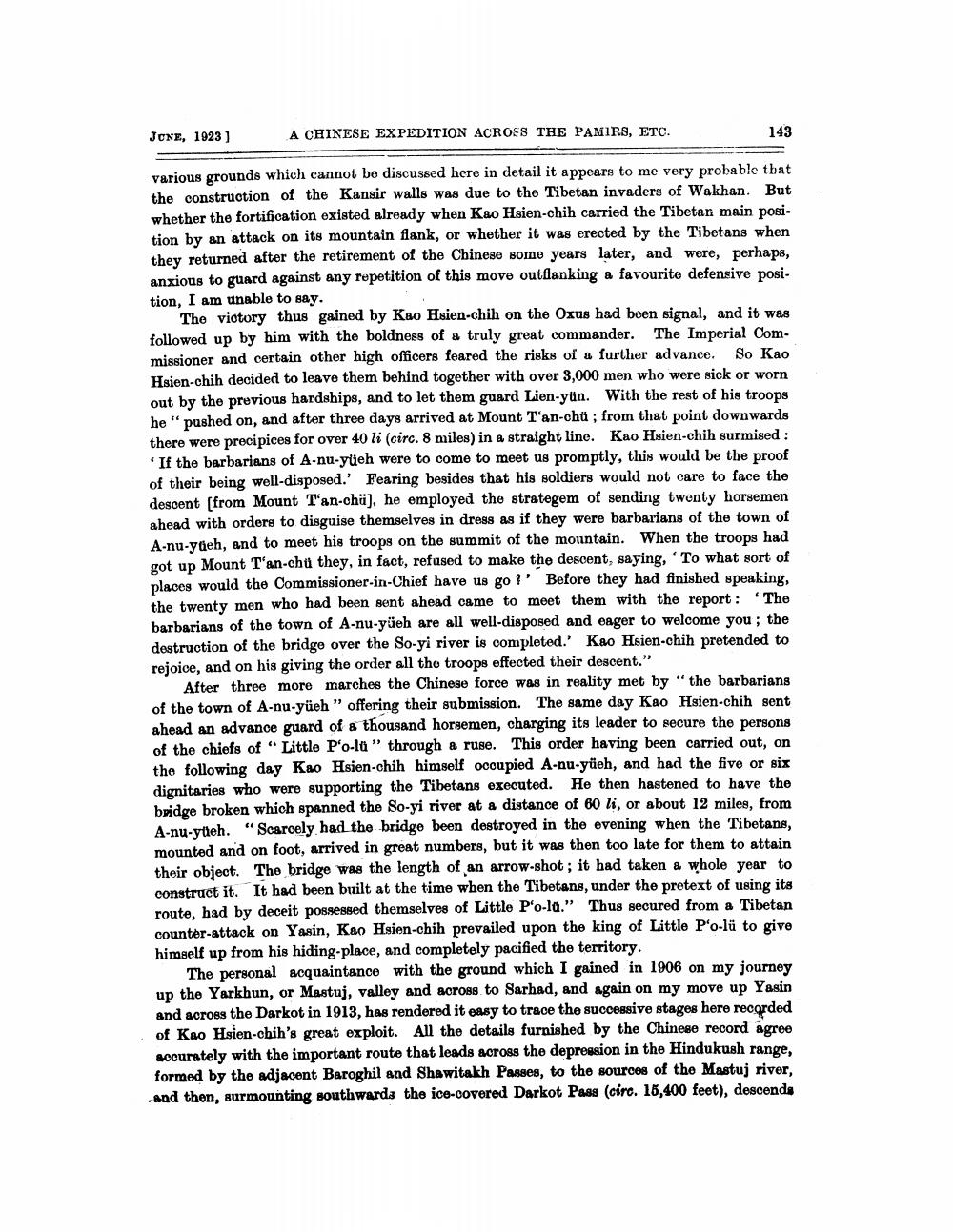________________
JCNE, 1923]
A CHINESE EXPEDITION ACROES THE PAMIRS, ETC.
143
various grounds which cannot be discussed here in detail it appears to me very probable that the construction of the Kansir walls was due to the Tibetan invaders of Wakhan. But whether the fortification existed already when Kao Hsien-chih carried the Tibetan main position by an attack on its mountain flank, or whether it was erected by the Tibetans when they returned after the retirement of the Chinese some years later, and were, perhaps, anxious to guard against any repetition of this move outflanking a favourite defensive position, I am unable to say.
The viotory thus gained by Kao Hsien-chih on the Oxus had been signal, and it was followed up by him with the boldness of a truly great commander. The Imperial Commissioner and certain other high officers feared the risks of a further advance. So kao Hsien-chih decided to leave them behind together with over 3,000 men who were sick or worn out by the previous hardships, and to let them guard Lien-yün. With the rest of his troops he "pushed on, and after three days arrived at Mount T'an-chü; from that point downwards there were precipices for over 40 li (circ. 8 miles) in a straight line. Kao Hsien-chih surmised: *If the barbarians of A-nu-yueh were to come to meet us promptly, this would be the proof of their being well-disposed.' Fearing besides that his soldiers would not care to face the descent (from Mount T'an-chü), he employed the strategem of sending twenty horsemen ahead with orders to disguise themselves in dress as if they were barbarians of the town of A-nu-ygeh, and to meet his troops on the summit of the mountain. When the troops had got up Mount T'an-chu they, in fact, refused to make the descent, saying, 'To what sort of places would the Commissioner-in-Chief have us go ?' Before they had finished speaking, the twenty men who had been sent ahead came to meet them with the report: The barbarians of the town of A-nu-yüeh are all well-disposed and eager to welcome you ; the destruction of the bridge over the So-yi river is completed.' Kao Hsien-chih pretended to rejoice, and on his giving the order all the troops effected their descent."
After three more marches the Chinese force was in reality met by “the barbarians of the town of A-nu-yüeh" offering their submission. The same day Kao Hsien-chih sent ahead an advance guard of a thousand horsemen, charging its leader to secure the persons of the chiefs of "Little Po-la " through a ruse. This order having been carried out, on the following day Kao Hsien-chih himself occupied A-nu-yueh, and had the five or six dignitaries who were supporting the Tibetans executed. He then hastened to have the bridge broken which spanned the So-yi river at a distance of 60 li, or about 12 miles, from A-nu-yueh. “Scarcely had the bridge been destroyed in the evening when the Tibetans, mounted and on foot, arrived in great numbers, but it was then too late for them to attain their obiect. The bridge was the length of an arrow-shot; it had taken a whole year to construct it. It had been built at the time when the Tibetans, under the pretext of using its route, had by deceit possessed themselves of Little P'o-la.” Thus secured from a Tibetan counter-attack on Yasin, Kao Hsien-chih prevailed upon the king of Little Po-lü to give himself up from his hiding-place, and completely pacified the territory.
The personal acquaintance with the ground which I gained in 1906 on my journey up the Yarkhun, or Mastuj, valley and across to Sarhad, and again on my move up Yasin and across the Darkot in 1913, has rendered it easy to trace the successive stages here recorded of Kao Hsien-chih's great exploit. All the details furnished by the Chinese record agree accurately with the important route that leads across the depression in the Hindukush range, formed by the adjacent Baroghil and Shawitakh Passes, to the sources of the Mastuj river, and then, surmounting southwards the ice-covered Darkot Pass (circ. 15,400 feet), descende




